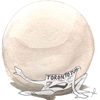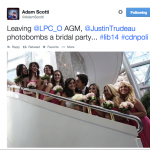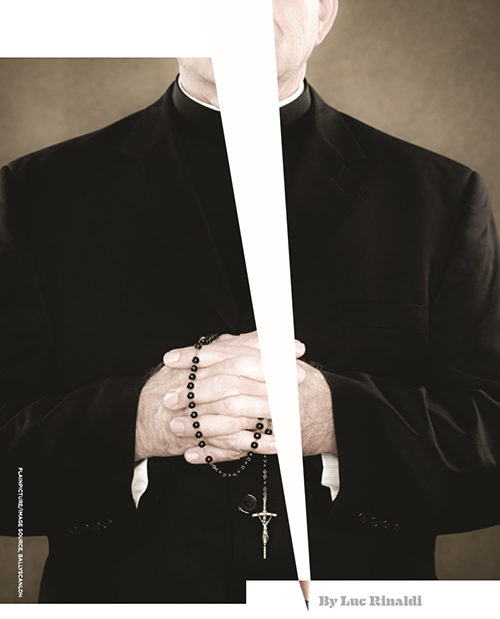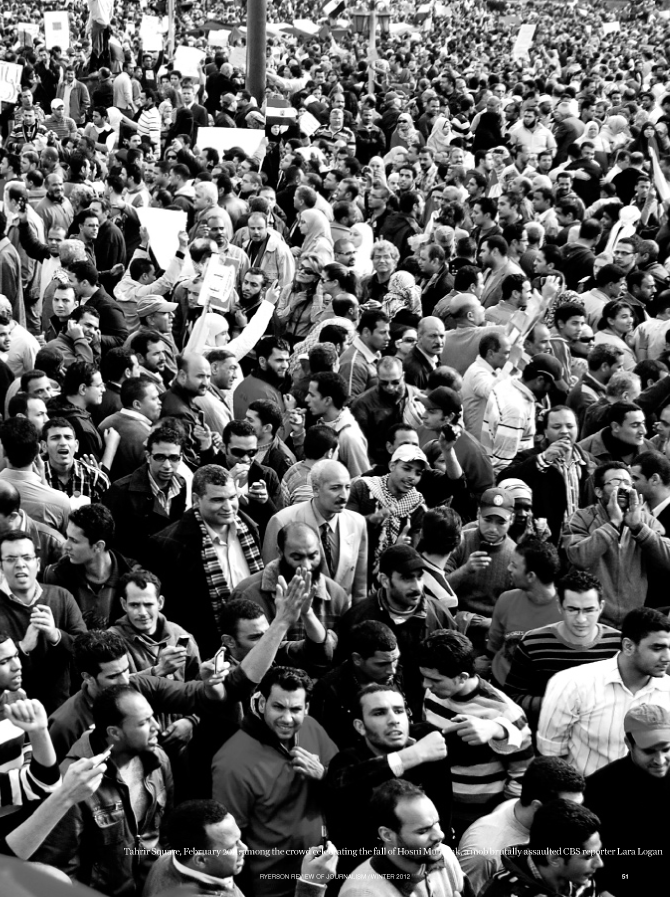Breaking faith: are religious newspapers reporting or preaching?
Why Christian outlets are now PR arms of the churches they once held accountable
By Luc Rinaldi
I don’t have a story.
That’s my first thought as I emerge from a downtown subway station on an overcast October afternoon in 2011. I’m on assignment to cover a pro-life rally for The Catholic Register, a Toronto-based religious weekly, but the small turnout—two dozen picketers line the sidewalk—hardly constitutes news. As I approach and read their homemade signs (“Abortion is a right not a luxury”), I realize these are the wrong protestors. I’m here to cover a rally—but not this one.
I cross the street. Here are the chosen people. Hundreds of them crowd a makeshift stage, mouths covered with red tape, “Defund abortion” signs hoisted high in the air. A band of twentysomethings happily plays Coldplay and Mumford & Sons covers. I snap a few photos and listen to speeches. As the rally ends, the protestors make a cross of flowers on the cobblestone path. The images, the rhetoric, the joyous mood: it’s all familiar fare for me, a lifelong Catholic and pro-lifer.
My story, published the following week, quoted only pro-lifers and reported statistics from a poll, issued by the rally’s organizers, that I never corroborated. For three years, I wrote for the Register, which is owned by the Archdiocese of Toronto. I covered an anti-abortion march on Parliament Hill. I went looking for blood when an online pro-life outlet accused Free the Children founders Craig and Marc Kielburger of supporting abortion. I wrote about a cross-country right-to-life tour, wearing one of its shirts—“PRO LIFE” in thick black letters across my chest—as I marched along Toronto’s Queen Street. When a middle-aged couple drove by, shaking their heads and giving me the finger, I felt only mildly offended. I’m not really a part of this, I thought to myself. I’m just a journalist.
In the world of Christian journalism, the Register, launched in 1893, is a relative success story. Under current editor Jim O’Leary, a journalist with 22 years of experience writing and editing for Sun Media, it was chosen by the Catholic Press Association as the best national Catholic newspaper in Canada and the United States for 2012. Still, its content is confined by the magisterium of the Church—in other words, it won’t run articles or views contrary to Catholic teaching, which explains my abortion coverage. If Catholics want the other side of the story, they won’t find it in the Register.
They aren’t the only ones. Corporate communications and PR are replacing critical reporting on issues that matter to Christians. As religious institutions shrink and weekly service attendance dwindles—roughly one-fifth of Canadians attend a service every week, compared to nearly one-third in 1985—communications directors and church executives are suddenly filling editorial positions that journalists held for decades. Many publications are shutting down entirely. Christian newspapers and magazines, traditionally watchdogs of the faith, are increasingly becoming tools of proselytization, preaching instead of reporting.
***
In early 2014, the Edmonton-based Western Catholic Reporter underwent the most drastic change it’s experienced in its 50-year history. The archdiocese replaced $750,000 of the paper’s budget, which was drawn from local parishes’ service collections, with a $350,000 grant. Whereas 32,000 parishioners once received the paper free, the Reporter now sells subscriptions. Even with up to 200 new subscriptions every week, circulation has fallen to about 7,000. As a result, the paper, weekly since 1965, comes out twice a month. The paper’s editorial staff became a branch of the archdiocese’s communications department. Editor Glen Argan, who once reported to a 10-member board of directors, now answers to the director of communications.
The Reporter reads much like the Register. The two have similar mandates, share content and subscribe to the same Catholic news wire, and both feature a mix of news and opinion pieces. Like the Register, the Reporter tends to toe the denominational line. For example, in the latter’s December 2, 2013, issue, five out of 21 stories are about the Vatican: the pope’s message on women in the Church, the pope’s vision for evangelization, the pope hugging a man with a disfiguring disease and so on. None features a dissenting voice.
In the short term, Argan, who has edited the Reporter for more than half of its existence, is hopeful the changes won’t affect the content. He’s less optimistic about the future. “To talk about the journalistic integrity of the Western Catholic Reporter may be a moot point,” he says. “It’s hard to say that there will even be a newspaper here 10 years from now.”
If the Reporter folds, it won’t be the first to do so. Since 2006, Montreal’s English-language Catholic Times; the east coast’s Atlantic Catholic; the contrarian, Toronto-based Catholic New Times; and BC Christian News have gone under. South of the border, at least another half-dozen outlets have met the same fate.
The situation is scarcely less bleak among the survivors, who face the ruinous combination of a dying print journalism industry and fading religious affiliation. In September 2013, the Associated Church Press issued a formal statement warning that, among Christian publications still in print, professional journalism and editorial freedom are being sidelined by public relations, promotion and fundraising. Winnipeg-based monthly Mennonite Brethren Herald is a prime example: founded 52 years ago with a team of young Mennonites at its helm, the magazine had a rebellious streak, drawing the ire of Church leaders. Now, the Herald’s editor is also the denomination’s interim communications director, and the magazine runs official Church press releases on its website. The bishop’s office in Vancouver, meanwhile, has asked The B.C. Catholic to avoid certain stories. And the paper’s editor, Malin Jordan, says self-censorship among writers has created a “culture of protection.” The Reporter may still be alive, but its recent makeover reflects a wider trend among Christian publications. In October 2013, when it published an editorial headlined “WCR still has lots of life in it,” the desperation was palpable.
***
Inside St. Chad’s Anglican Church, Archdeacon Paul Feheley hurries toward the altar, cutting through a silent Sunday congregation of 30. Dressed in robes, he hooks around the pews at the front of the church—a homey wooden hall tinted with stained-glass light—and takes a seat at the organ. His hands glide over the keys as he belts out the opening hymn. Throughout the service, Feheley rushes gracefully between altar and organ, piano and pulpit, pew and punchline. When a baby begins to cry, he jokes: “He hasn’t even heard the sermon yet.”
Feheley is not only the pastor of the Toronto parish; he’s the organist, preacher and cantor too. He is also principal secretary to the archbishop of the Anglican Church of Canada (ACOC). He’s not someone who needs an extra job. But in January 2013, he got one: interim editor of the Anglican Journal, the largest faith-based newspaper in North America. The 140-year-old monthly, long a self-professed champion of editorial integrity, is the denomination’s paper of record, and once had a reputation for holding the Church to account. ACOC funds the Journal, which has a national circulation of 150,000. But, historically, the relationship between the Church and the Journalhas been strained: ACOC’s national office has fired editors, locked reporters out of meetings and reportedly stopped sharing information with staff because of distrust. “I knew it was a bit of a strange appointment,” says Vianney Carriere, the communications director, who chose Feheley as editor. “It requires a pretty rigorous compartmentalization to keep the roles separate.”
The decision shocked Feheley—and he wasn’t the only one who was surprised. “I was totally and utterly horrified,” says Kristin Jenkins, his predecessor as editor. “It broke the most central rule of the publication. How can somebody linked to the Church’s decision-maker possibly be an arm’s-length editor?” When Jenkins left the paper—she says she was told the Journal would soon fold—the Church avoided the hassle and cost of finding another editor on short notice by appointing Feheley. He earns only a portion of what the average editor would; the extra money is funnelled into the newspaper, ensuring issues are 12 pages instead of the eight-page ones typical at the end of Jenkins’s editorship. The duration of Feheley’s post will depend on how long it takes to hire a replacement, though an editor’s salary is included in the Church’s 2014 budget. “There’s a long line of good journalists who have headed the newspaper,” says Jenkins, adding that readers expect that trend to continue. “Maybe Paul’s appointment is more valuable for the Church, but is it more valuable for readers?”
Some readers don’t think so. In a letter to the editor published in the Journal’s March 2013 issue, Canon Rod Gillis, a retired minister, lambasted the decision and warned of its “implications for editorial independence, conflict of interest and transparency.” Readers like Gillis probably remember the Journal as the newspaper that published supplements such as “Sins of the Fathers,” a 16-page May 2000 investigation into the Church’s involvement in residential schooling and sexual assault. “That was the best piece of journalism I’ve been associated with anywhere,” says former editor David Harris, who commissioned the piece. (He’s worked at the National Post and Halifax’sThe Chronicle Herald; he now edits the independent Presbyterian Record.) By contrast, an eight-page May 2013 Journal supplement, the latest in a series of annual ministry reports that the Church began running in the paper three years ago, contained a glowing profile of Archbishop Frederick Hiltz, Feheley’s boss and friend, and a regular Journal contributor (one line reads: “Archbishop Hiltz has an exhausting job. He pays the price in grey hair and health”).
Jenkins says the Journal has become less news-focused and more pastoral under Feheley’s direction. The October 2013 issue, for example, had four news stories over 12 pages; the rest was homiletic reflection and op-ed, with the first five pages written entirely by clergy. (The October 2012 issue, edited by Jenkins, contained 12 news stories.) That’s not to say Feheley isn’t aware of Church news. In his position as principal secretary to the archbishop, he vets all emails sent to Hiltz. He’s often the first person to know what’s happening in the Church—he just can’t publish it. Last October, Feheley learned of an Iqaluit cathedral’s $3-million debt, but the Journal covered it only after the news went public a week later. Earlier that year, the paper surrendered another scoop, because Feheley wanted to let the diocesan paper in Brandon, Manitoba, break a story about the local bishop’s ordained son’s alleged misuse of a diocesan credit card. The Journal story came a month after Feheley first heard about the supposed $200,000 fraud—which hasn’t been proven in court—and a day after the Winnipeg Free Press and Brandon Sun reported it. It was posted online but never went to print. (According to a 2012 survey, 77 percent of Journal readers never visit the paper’s website.)
When I first sit down with Feheley at a cafe near the Anglican Church of Canada’s offices in midtown Toronto, he’s quick to acknowledge that his roles conflict. In fact, by the end of his first sentence, he’s already mentioned “editorial independence.” At this point, I’ve heard the term thrown around enough to know that, in the world of religious journalism, it’s relative. Communications workers on a bishop’s leash claim the same sort of integrity as arm’s-length editors. But it’s hard to boast of independence when the subject of most of your stories is the institution that keeps you afloat. (Although there are some non-Christian religious publications in Canada, only a few, such as the Toronto-based Canadian Jewish News, have a large readership or a history of editorial independence.)
Back in St. Chad’s, I drop a toonie into the collection basket. Some part of that will help the Journal survive. The paper—like the Register and others—receives much of its funding through parish collections. At the end of mass, I chat with Feheley at the back of the church. After a short discussion, we discover that we both attended St. Michael’s Choir School, a Roman Catholic boys’ school in downtown Toronto. After graduating, Feheley converted and, 35 years ago, became an Anglican priest. My story is different.
***
I can’t remember a time when I didn’t have my neon-green plastic briefcase. It sat in my closet, filled with religious keepsakes: a children’s Old Testament with a cartoon Moses on the cover, a New Testament I received for my First Communion, a build-it-yourself rosary set and dozens of other trinkets. Whenever I received a sacrament, went on a retreat or participated in a church event, I put a token in the briefcase for posterity.
My faith grew stronger in Grade 10, when I participated in a Catholic leadership retreat north of Toronto. Over the next two years, I attended, led and helped found several more retreats in Ontario and the northern U.S. In my final year of high school, I visited classrooms to recite the rosary with students once a month, and I sang and played guitar at school masses. I started volunteering at a church where I helped provide the soundtrack to prayer vigils and Eucharistic adoration. I joined the Register’s youth team and, in the summer before university, worked in the newsroom. I considered the priesthood. The crosses, medallions, rosaries, books, newspapers and pamphlets I collected along the way all wound up in my briefcase.
In my first year of journalism school, I joined the Catholic chaplaincy on campus. Interested in combining my faith with my trade, I wrote a story asking if Ontario’s Catholic school system—in which I’d spent 14 years—should be publicly funded. I set out to prove that it should; I ended up drawing the opposite conclusion. Although my change of heart was about Catholic schools, and not Catholicism itself, the assignment lingered with me, encouraging me to question my faith, the same way I would a story.
That summer, when I returned to the Register, I spent my downtime reading Richard Dawkins’s The God Delusion and browsing atheist forums instead of pitching stories. Over the next year, I continued to lead retreats and play music at masses, and I continued to file away the relics of my Catholicism in the green briefcase. But the practice was not about safekeeping anymore—I was hiding the reminders of a faith I no longer kept.
One warm summer night in 2012, I sat in my father’s grey Honda Accord with my closest Catholic friend. “I’m agnostic,” I told him, tears rolling down my cheek. A few weeks later, my family moved out of our house. I left the green briefcase behind.
***
David Wilson’s kids would never be caught darkening the door of a church. In his eight years editing the award-winning United Church Observer, Wilson has tried to make the monthly accessible for believers, and for readers more akin to his children. So far, it’s worked. The magazine, long lauded as a shining example of independent religious journalism, won more awards in 2012 than any other American or Canadian publication in the Associated Church Press, and was crowned best magazine by the Canadian Church Press the same year.
The September 2013 issue illustrates why. Church-centric content, including an in-depth reader survey and a story about the merits of reading the Bible, made up roughly half of the book. Meanwhile, an essay lamented the absence of ethics in the debate around a Toronto casino, while an investigative feature traced diluted bitumen from Alberta’s oil sands to a spill in a small town in Arkansas. It’s not typical church fare—because the Observer is not a typical church organ. Last summer, as other religious outlets gradually lost hold of their journalistic integrity, the magazine created and signed a “covenant”—a contract outlining all aspects of the magazine’s relationship with the Church, enshrining its editorial and operational independence.
The Observer isn’t the only publication to make the case for a feisty, independent religious press. Geez, an eight-year-old, ad-free quarterly, is like Adbusters for Christians. That’s no surprise, considering its founder, Aiden Enns, is a former managing editor of the anti-consumerist magazine. You can see traces of the Adbustersethos in Geez’s regular Civil Disobedience section and Feministry department, or in its Fall 2013 issue, which was entirely dedicated to peace activism (including a “Plan Your Own Peace Action” guide). The cover package of the Winter 2013 issue was a series of sermons you’d never hear in church; one line reads, “Get out of the church. Run!”
“Faith-based periodicals are important vessels,” says Enns, “especially if they take their journalistic mandate seriously.” But Geez’s independence comes at a price. With roughly 1,400 subscribers, it has four part-time staff members, who earn $12 an hour—the same wage I made as a summer student at the Register.
***
Coverage of religion is also in decline at secular, mainstream newspapers. Neither the Toronto Star nor The Globe and Mail has a dedicated religion reporter or editor. Positions once occupied by veteran journalists have been slashed thanks to cutbacks. In 2007, the Star’s managing editor moved the religion page, which typically consisted of a feature and two columns, from the Life section to the Insight section. It sputtered for a few months before disappearing altogether. Libby Stephens, who edited the page, says problems arise when general editors handle religion stories. “I’m not asking that they know the specifics—the difference between Convention Baptists and Evangelical Baptists—I’m just asking for someone who knows the story of the Good Samaritan,” she says, adding that religion plays into a significant number of news stories. “If you don’t have some grasp of that, you’re giving a very shallow, millimetre-deep recitation of what’s happened, without any context.”
Douglas Todd, The Vancouver Sun’s religion and diversity reporter, is just about the only one providing that context. The last journalist left on the beat, he self-assigns three-quarters of his stories because his editors have less knowledge of faith than he has. Until recently, Charles Lewis reported on religion for the National Post and edited its Holy Post religion blog. But the paper opted not to appoint a new full-time religion reporter when Lewis left for health reasons in December 2013, and today the fate of the blog is uncertain. Lewis says a tendency not to treat religion as a serious beat plays into secular journalists’ coverage of faith. “It’s the only beat at the paper where you cover people who adhere to something that’s invisible,” he says. “Unions have contracts. Miners have holes in the ground. We have God.”
Twenty-five million Canadians have God, or at least some sort of faith, according to 2011 Statistics Canada data. But that bald stat does little justice to the complex religious narrative of an increasingly diverse, secular country. Only two-fifths of us view our faith as important in our lives and, since 2001, the number claiming no religious affiliation has risen from five million to nearly eight million. If secular journalists won’t provide informed religion reporting to the audience that remains, then religious reporters must. Religion is at the root of some of the world’s most heated international conflicts and is often behind aid that comes in their wake. Like anything else, it should be constantly questioned, prodded and tested against truth. At its best, journalism serves truth, and truth has the power to topple beliefs like dominoes.
***
A few days after attending mass at St. Chad’s, I run into Feheley as I walk to an interview. He’s heading back to the ACOC office after an appointment at the diocese’s headquarters. It’s a trip he makes often, cycling between his different duties. He’s forever caught in-between—between offices, between organ and altar, between propagating the Church’s official message as the archbishop’s secretary, preaching it as a pastor and commenting on it as an editor.
The Journal and outlets like it are similarly between roles, forced to choose between adhering to doctrine and risking closure. When I ask Feheley about the paper’s role under his editorship, he says, “The Journal needs to be able to tell the Church about the Church in a way that doesn’t simply reflect what upper management thinks.” I’m reminded of this when, in the next issue, I read his editorial, an honest questioning of the ACOC’s stance—or lack thereof—on euthanasia. “I, for one,” Feheley writes, “need the Church to speak.” What he doesn’t realize is that he speaks for the Church.
This piece was published in the Spring 2014 issue of the Ryerson Review of Journalism.
Related Posts
 The Little Paper That Shrank
The Little Paper That Shrank  Was Justin Trudeau’s boycott of Sun Media justified or an unfair obstruction?
Was Justin Trudeau’s boycott of Sun Media justified or an unfair obstruction?  Mental health: why journalists don’t get help in the workplace
Mental health: why journalists don’t get help in the workplace Sally Armstrong: the editor who changed women’s magazines
Sally Armstrong: the editor who changed women’s magazines Why conservative columnists can’t live up to Peter Worthington
Why conservative columnists can’t live up to Peter Worthington Fear and loathing on the campaign trail
Fear and loathing on the campaign trail
by Luc Rinaldi
Luc Rinaldi was the Senior Editor for the Spring 2014 issue of Ryerson Review of Journalism.










































